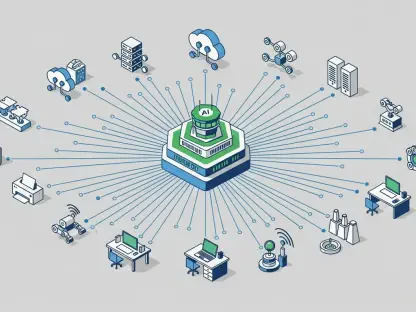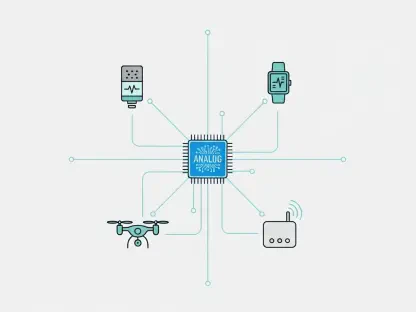Imagine a world where mundane, repetitive tasks are handled not by humans but by intelligent software robots, freeing up countless hours for innovation and strategic thinking. In this rapidly evolving landscape of enterprise automation, one company stands out as a dominant force, yet its stock price seems to defy its market position. Despite leading the charge in Robotic Process Automation (RPA), a sector projected to reach a staggering $22.79 billion valuation this year with a compound annual growth rate of 43.9% through the next several years, this industry giant’s valuation paints a picture of disconnect. For investors with a keen eye for opportunity, this gap between market perception and fundamental strength presents a compelling case. As automation becomes a cornerstone of modern business, understanding why this leader is undervalued could unlock significant potential for those willing to look beyond surface-level metrics.
1. Valuation Discrepancy: A Contrarian Opportunity
The financial metrics of this automation frontrunner reveal a stark contrast between traditional indicators and future potential. With a trailing P/E ratio of -108 and an EV/EBITDA of -244.6x, conventional investors might shy away, viewing these figures as warning signs. However, such numbers obscure the structural advantages held by the company. Compared to the RPA industry’s average forward P/E ratio of 28.87, the company’s forward P/E stands at a more attractive 19.58, suggesting it trades at a discount. Additionally, a P/S ratio of 4.9 falls below the industry average of 5.85x. Given a reported 9% year-over-year revenue growth and a 14% increase in annual recurring revenue (ARR) for the current fiscal year, this valuation appears misaligned with the firm’s underlying performance. This discrepancy could signal an underappreciated asset in a high-growth sector, drawing attention from contrarian investors looking for hidden value.
Beyond the raw numbers, the broader industry context further highlights why this company’s stock might be undervalued. The RPA market is not merely growing; it is exploding with demand as businesses across sectors seek to optimize operations through digital transformation. While competitors struggle to match the pace of innovation, this company has consistently demonstrated an ability to stay ahead of the curve. Its financial metrics, when viewed through a forward-looking lens, suggest a potential mispricing by the market. A PEG ratio of 1.06, combined with robust growth indicators, points to a stock that may not yet reflect the true scope of its long-term earnings potential. For those willing to dig deeper, the opportunity lies in recognizing that today’s negative earnings are often a precursor to tomorrow’s profitability in tech-driven, high-growth industries like automation.
2. Financial Strength Amidst Rapid Expansion
Delving into the financial health of this automation leader reveals a story of resilience and strategic discipline. Despite posting a GAAP operating loss of $163 million in the current fiscal year, the company has managed to generate an impressive $328 million in non-GAAP adjusted free cash flow. With $1.7 billion in cash reserves, it maintains a strong balance sheet capable of weathering short-term challenges. A dollar-based net retention rate of 110% and 14% ARR growth underscore a recurring revenue model that is both sticky and scalable. These figures are particularly notable for a company still in a significant growth phase, illustrating an ability to effectively monetize an expanding customer base. Such financial fortitude positions the firm as a standout in a competitive landscape where many struggle to balance growth with stability.
Moreover, strategic moves and innovative offerings enhance the company’s financial narrative. Leadership in agentic automation—integrating AI, orchestration, and RPA—places it at the forefront of the next wave of digital transformation. Partnerships with major entities and cutting-edge product releases further solidify its market position. These initiatives are not mere buzzwords but tangible drivers of growth, as evidenced by an ARR of $1.666 billion, with projections to reach $1.82 billion in the coming fiscal year. While some might point to negative earnings as a cause for concern, the non-GAAP operating income of $241 million and early signs of GAAP profitability in recent quarters suggest a clear path forward. This combination of financial discipline and forward-thinking innovation makes a strong case for sustained growth in an industry hungry for efficient solutions.
3. Strategic Positioning and Market Risks
The competitive edge of this automation titan lies in its ability to innovate at scale, but execution remains a critical challenge. With a substantial cash reserve and non-GAAP gross margins of 85%, the company has the resources to navigate potential pitfalls. Its pioneering role in agentic automation, a market opportunity estimated at $100 billion, creates a formidable barrier against rivals. This strategic positioning is not just about maintaining a lead but expanding it through continuous advancements in technology and customer engagement. A net retention rate of 110% indicates not only customer loyalty but also successful upselling, a key driver of long-term revenue. However, the question remains whether the pace of innovation can be sustained while scaling operations globally in a highly dynamic sector.
Risks are inherent in such a fast-paced environment, yet the rewards could be substantial for those who see the bigger picture. Market competition is fierce, with other players vying for a share of the RPA pie, but this company’s financial buffer and technological leadership provide a cushion. The primary risk lies in potential missteps during rapid expansion—whether through overextension or failure to adapt to evolving customer needs. Nevertheless, current valuation metrics, including a forward P/E of 19.58, suggest the stock may not fully account for the firm’s growth trajectory. For investors, the focus should be on monitoring key performance indicators like ARR guidance and the adoption rate of new automation tools. Balancing these risks against the backdrop of an industry set to grow at a 43.9% CAGR reveals a nuanced but potentially lucrative investment landscape.
4. Looking Ahead: Navigating the Automation Future
Reflecting on the journey so far, the path of this automation leader has been marked by a blend of bold innovation and calculated financial management. Strategic partnerships and product advancements have laid a solid foundation for capturing market share in a sector that redefines business efficiency. The company’s ability to turn early GAAP profitability signals into consistent performance is a testament to its operational focus, even as it navigates the complexities of negative traditional metrics. Historical growth in ARR and customer retention has already proven that the market’s undervaluation is more a matter of perception than reality, setting the stage for future recalibration.
As the automation revolution continues to unfold, actionable steps can guide investors and industry watchers alike. Keeping a close eye on upcoming quarterly guidance for revenue and ARR will provide critical insights into sustained momentum. Tracking the adoption of cutting-edge tools within the agentic automation space will be equally important, as these innovations could redefine competitive dynamics. Additionally, comparing valuation metrics with industry peers offers a benchmark to assess whether the market has corrected its pricing stance. In a world where automation is no longer optional but essential, recognizing the latent potential in this undervalued leader could yield significant returns for those who act with foresight.









